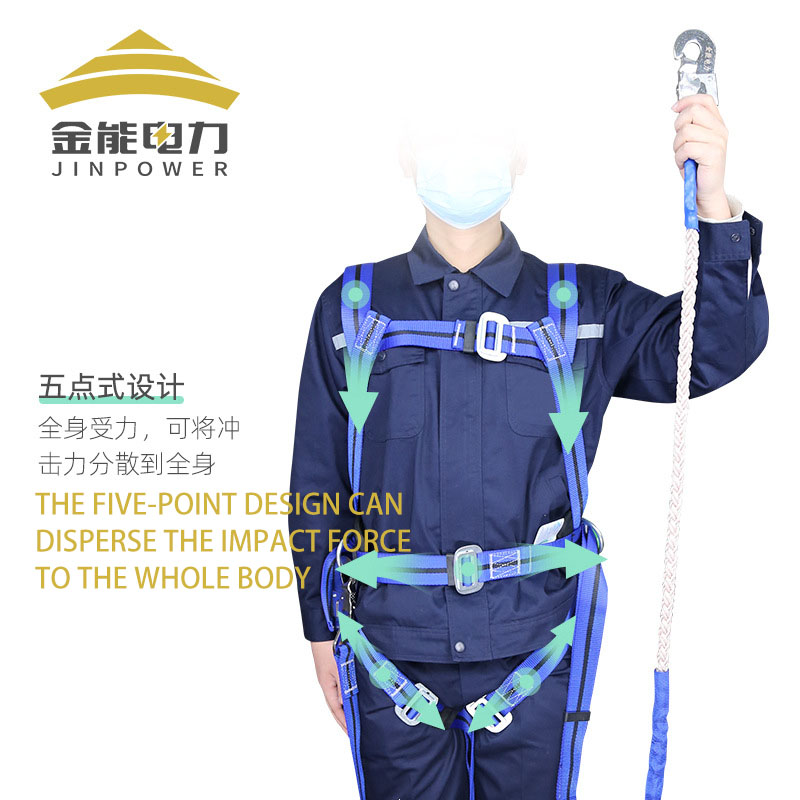In the high-risk arena of high-altitude work, safety harnesses undoubtedly play a pivotal role in safeguarding workers’ lives. However, a tragic accident serves as a somber reminder: even with a safety harness in place, neglecting its quality and disposal standards can still result in devastating outcomes.
A Wake-Up Call from Tragedy
On April 8, 2021, a tragic accident occurred at a power company during high-altitude operations. While moving along structural components, a worker accidentally fell. Although he was wearing a safety harness, the back connection point broke, failing to prevent the fall and ultimately leading to his death. This heartbreaking incident not only brought immense sorrow to the victim’s family but also served as a stark warning about the importance of safety measures.
1. Service Life of Safety Harnesses
(1) Pole Work Safety Harnesses
·General lifespan: No more than three years.
·Annual inspection by a professional institution is mandatory.
·Within two years of purchase, two samples from the same batch should undergo dynamic and static mechanical performance tests in accordance with GB6095 standards. If the samples fail, the entire batch must be discontinued. Subsequent random testing is required annually.
(2) Area Restriction Safety Harnesses
·General lifespan: No more than five years.
·Within two years of purchase, two samples from the same batch should undergo static mechanical performance tests in accordance with GB6095 standards. If the samples fail, the entire batch must be discontinued. Subsequent random testing is required annually.
(3) Fall Arrest Harnesses
·General lifespan: No more than five years.
·After any fall incident, the harness must be inspected by a professional. If damage affecting performance is identified, it should be replaced immediately.
·Within two years of purchase, two samples from the same batch should undergo dynamic and static mechanical performance tests in accordance with GB6095 standards. If the samples fail, the entire batch must be discontinued. Subsequent random testing is required annually.
Note: For fall protection equipment exceeding its service life, continued use requires semi-annual inspections. Only qualified harnesses may be used, and lifespans should be shortened in harsh environments or under high-frequency usage.
2. Disposal Standards for Safety Harnesses
(1) Overall Disposal Inspection Items
·Performance Requirements: The buckle should remain intact; the simulated dummy should not detach or fall to the ground; connectors must not open; and no parts should break.
·Impact Force: Peak force should not exceed 6 kN.
·Extension Length: Should not exceed the value specified in the product’s permanent markings.
·Suspension Position: When suspended, the dummy’s head should not tilt downward, and no metal parts should press against sensitive areas such as the neck or inner thighs.
·Webbing Movement: Maximum slip in adjustment buckles should not exceed 25 mm.
·Fall Indicators: If the harness has a fall indicator, it should function correctly after a fall.
(2) Hardware Components
·Components such as buckles, D-rings, and safety rope hooks must remain free from damage, cracks, or deformation. They should also have no sharp edges, burrs, corrosion, or wear.
(3) Webbing and Stitching
·Webbing must be free from wear, cuts, or broken fibers. Check for signs of tearing, mold, burns, or fading.
·Stitching should not appear stretched or cut. Any breakage could indicate the harness has experienced impact loading and should be discontinued.
(4) Impact Indicators
·For harnesses with fall indicators, if the indicator has been activated, the harness must be taken out of service and destroyed.
(5) Unreadable Labels
·If the harness label becomes illegible within its service life, making it impossible to determine the product's validity, the harness should be discarded.

![]()
3. Daily Management and Precautions
(1) Storage and Handling
·Harnesses should be stored away from high temperatures, open flames, strong acids, and sharp objects.
·Periodic visual inspections should be conducted during storage to identify any abnormalities requiring replacement.
(2) Pre-Use Inspections
·Inspect the harness and its components for damage, wear, or breakage before each use. Ensure all connections are secure.
(3) Proper Use
·Follow the user manual and operational guidelines to ensure proper use of the harness. Adjust straps to appropriate lengths and avoid unauthorized modifications.
The accident investigation revealed critical lapses:
·Subcontractors failed to uphold safety responsibilities, allowing secondary subcontracting.
·Safety equipment procurement, inspection, and management were poorly executed.
·Site supervisors neglected to identify non-compliance issues with safety harnesses.
As the "lifeline" for high-altitude workers, safety harnesses are of utmost importance. Over time, wear, aging, and environmental factors can degrade their effectiveness. Strict adherence to disposal standards is vital to protect the lives of every worker operating at height.

